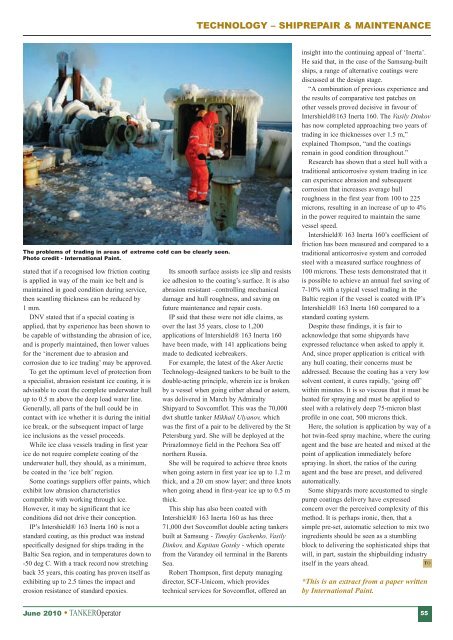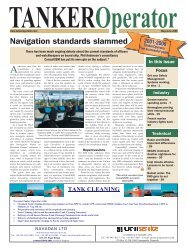Features: - Tanker Operator
Features: - Tanker Operator
Features: - Tanker Operator
Create successful ePaper yourself
Turn your PDF publications into a flip-book with our unique Google optimized e-Paper software.
TECHNOLOGY – SHIPREPAIR & MAINTENANCE<br />
The problems of trading in areas of extreme cold can be clearly seen.<br />
Photo credit - International Paint.<br />
stated that if a recognised low friction coating<br />
is applied in way of the main ice belt and is<br />
maintained in good condition during service,<br />
then scantling thickness can be reduced by<br />
1 mm.<br />
DNV stated that if a special coating is<br />
applied, that by experience has been shown to<br />
be capable of withstanding the abrasion of ice,<br />
and is properly maintained, then lower values<br />
for the ‘increment due to abrasion and<br />
corrosion due to ice trading’ may be approved.<br />
To get the optimum level of protection from<br />
a specialist, abrasion resistant ice coating, it is<br />
advisable to coat the complete underwater hull<br />
up to 0.5 m above the deep load water line.<br />
Generally, all parts of the hull could be in<br />
contact with ice whether it is during the initial<br />
ice break, or the subsequent impact of large<br />
ice inclusions as the vessel proceeds.<br />
While ice class vessels trading in first year<br />
ice do not require complete coating of the<br />
underwater hull, they should, as a minimum,<br />
be coated in the ‘ice belt’ region.<br />
Some coatings suppliers offer paints, which<br />
exhibit low abrasion characteristics<br />
compatible with working through ice.<br />
However, it may be significant that ice<br />
conditions did not drive their conception.<br />
IP’s Intershield® 163 Inerta 160 is not a<br />
standard coating, as this product was instead<br />
specifically designed for ships trading in the<br />
Baltic Sea region, and in temperatures down to<br />
-50 deg C. With a track record now stretching<br />
back 35 years, this coating has proven itself as<br />
exhibiting up to 2.5 times the impact and<br />
erosion resistance of standard epoxies.<br />
Its smooth surface assists ice slip and resists<br />
ice adhesion to the coating’s surface. It is also<br />
abrasion resistant –controlling mechanical<br />
damage and hull roughness, and saving on<br />
future maintenance and repair costs.<br />
IP said that these were not idle claims, as<br />
over the last 35 years, close to 1,200<br />
applications of Intershield® 163 Inerta 160<br />
have been made, with 141 applications being<br />
made to dedicated icebreakers.<br />
For example, the latest of the Aker Arctic<br />
Technology-designed tankers to be built to the<br />
double-acting principle, wherein ice is broken<br />
by a vessel when going either ahead or astern,<br />
was delivered in March by Admiralty<br />
Shipyard to Sovcomflot. This was the 70,000<br />
dwt shuttle tanker Mikhail Ulyanov, which<br />
was the first of a pair to be delivered by the St<br />
Petersburg yard. She will be deployed at the<br />
Prirazlomnoye field in the Pechora Sea off<br />
northern Russia.<br />
She will be required to achieve three knots<br />
when going astern in first year ice up to 1.2 m<br />
thick, and a 20 cm snow layer; and three knots<br />
when going ahead in first-year ice up to 0.5 m<br />
thick.<br />
This ship has also been coated with<br />
Intershield® 163 Inerta 160 as has three<br />
71,000 dwt Sovcomflot double acting tankers<br />
built at Samsung - Timofey Guzhenko, Vasily<br />
Dinkov, and Kapitan Gotsky - which operate<br />
from the Varandey oil terminal in the Barents<br />
Sea.<br />
Robert Thompson, first deputy managing<br />
director, SCF-Unicom, which provides<br />
technical services for Sovcomflot, offered an<br />
insight into the continuing appeal of ‘Inerta’.<br />
He said that, in the case of the Samsung-built<br />
ships, a range of alternative coatings were<br />
discussed at the design stage.<br />
“A combination of previous experience and<br />
the results of comparative test patches on<br />
other vessels proved decisive in favour of<br />
Intershield®163 Inerta 160. The Vasily Dinkov<br />
has now completed approaching two years of<br />
trading in ice thicknesses over 1.5 m,”<br />
explained Thompson, “and the coatings<br />
remain in good condition throughout.”<br />
Research has shown that a steel hull with a<br />
traditional anticorrosive system trading in ice<br />
can experience abrasion and subsequent<br />
corrosion that increases average hull<br />
roughness in the first year from 100 to 225<br />
microns, resulting in an increase of up to 4%<br />
in the power required to maintain the same<br />
vessel speed.<br />
Intershield® 163 Inerta 160’s coefficient of<br />
friction has been measured and compared to a<br />
traditional anticorrosive system and corroded<br />
steel with a measured surface roughness of<br />
100 microns. These tests demonstrated that it<br />
is possible to achieve an annual fuel saving of<br />
7-10% with a typical vessel trading in the<br />
Baltic region if the vessel is coated with IP’s<br />
Intershield® 163 Inerta 160 compared to a<br />
standard coating system.<br />
Despite these findings, it is fair to<br />
acknowledge that some shipyards have<br />
expressed reluctance when asked to apply it.<br />
And, since proper application is critical with<br />
any hull coating, their concerns must be<br />
addressed. Because the coating has a very low<br />
solvent content, it cures rapidly, ‘going off’<br />
within minutes. It is so viscous that it must be<br />
heated for spraying and must be applied to<br />
steel with a relatively deep 75-micron blast<br />
profile in one coat, 500 microns thick.<br />
Here, the solution is application by way of a<br />
hot twin-feed spray machine, where the curing<br />
agent and the base are heated and mixed at the<br />
point of application immediately before<br />
spraying. In short, the ratios of the curing<br />
agent and the base are preset, and delivered<br />
automatically.<br />
Some shipyards more accustomed to single<br />
pump coatings delivery have expressed<br />
concern over the perceived complexity of this<br />
method. It is perhaps ironic, then, that a<br />
simple pre-set, automatic selection to mix two<br />
ingredients should be seen as a stumbling<br />
block to delivering the sophisticated ships that<br />
will, in part, sustain the shipbuilding industry<br />
itself in the years ahead.<br />
TO<br />
*This is an extract from a paper written<br />
by International Paint.<br />
June 2010 TANKER<strong>Operator</strong> 55
















